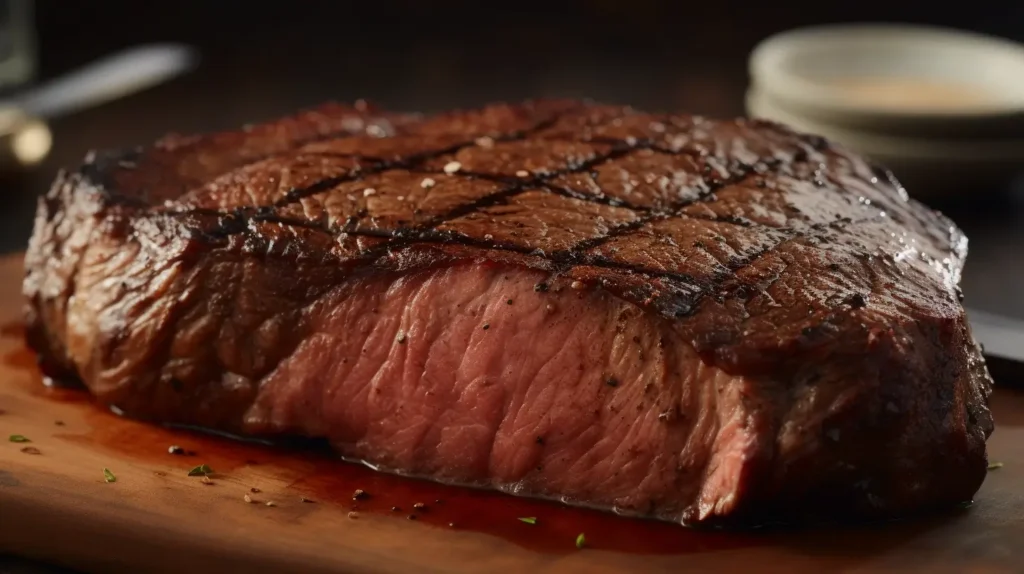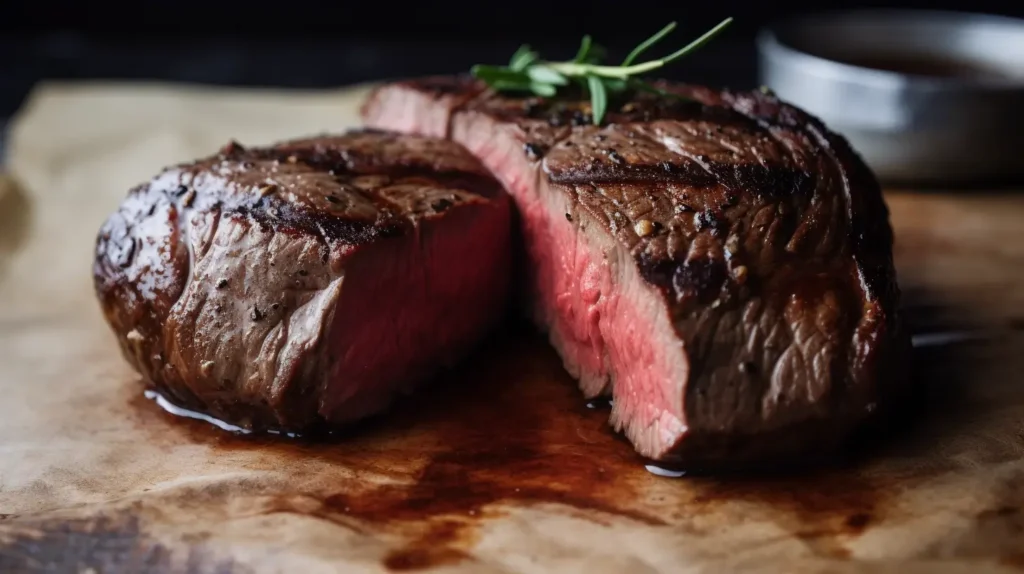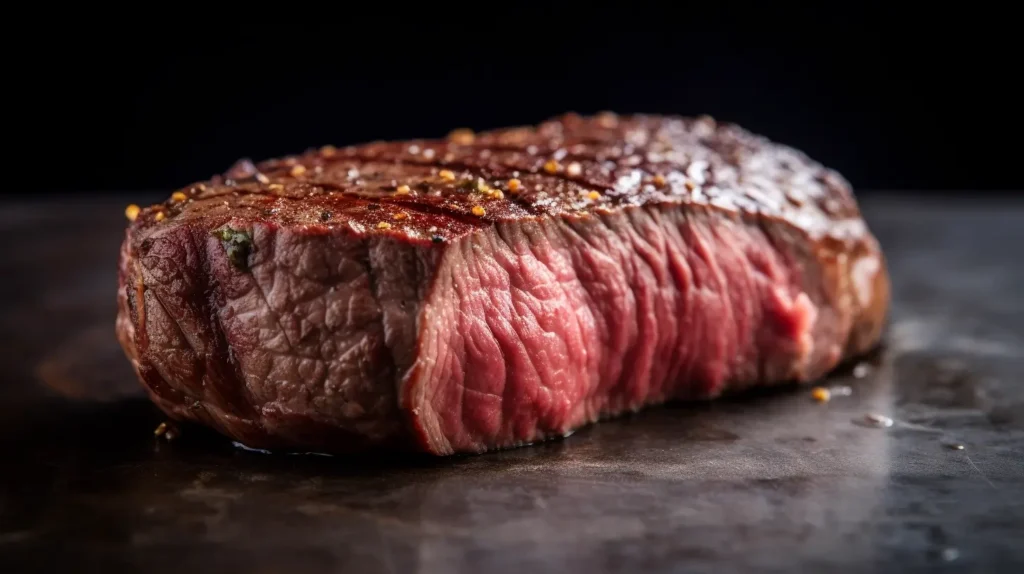Table of Contents
Steak Doneness: The Ultimate Guide to Cooking the Perfect Steak

Cooking steak to the right doneness is essential for achieving the ideal texture, flavor, and juiciness. Whether you prefer rare, medium-rare, or well-done, understanding internal temperatures and cooking techniques ensures a perfect result every time.
For precise cooking, using a steak cooking chart is crucial to avoid overcooking or undercooking your steak. If you’re working with thicker cuts, such as cowboy steak, special techniques like reverse-searing may be necessary for even doneness.
What Determines Steak Doneness?
The internal temperature of a steak is the most reliable way to measure doneness, but other factors also play a role.
Key Factors Affecting Doneness:
- Internal Temperature – The primary measure of doneness.
- Cooking Method – Grilling, pan-searing, and sous vide affect the final result.
- Thickness of the Steak – Thicker cuts need longer cooking times.
- Resting Time – Essential to keep juices intact after cooking.
For an accurate reference, use a steak temperature guide while preparing your steak.
Steak Doneness Levels and Internal Temperatures
Each level of doneness creates a unique eating experience.
1. Rare (120-130°F / 49-54°C)
- Cool, bright red center
- Very soft texture lightly warmed but mostly raw
- Seared on the outside with minimal internal cooking
2. Medium-Rare (130-135°F / 54-57°C)
- Warm, red center
- Slightly firmer than rare, yet still tender
- One of the most popular doneness levels
3. Medium (135-145°F / 57-63°C)
- Pink center, firmer texture
- Retains some juiciness but with more structure
- A good balance between tenderness and firmness
4. Medium-Well (145-155°F / 63-68°C)
- Slight pink in the center, firmer texture
- Lower moisture retention than medium
- Preferred by those who like minimal pinkness
5. Well-Done (155°F+ / 68°C+)
- Fully cooked, no pink inside
- Can be dry and firm if not cooked properly
- Requires careful preparation to avoid toughness
How to Tell If a Steak Is Done Without a Thermometer
If you don’t have a meat thermometer, you can estimate doneness using alternative methods.
1. Touch Test
Using your hand as a reference, compare the steak’s firmness to different parts of your palm:
- Rare – Soft, like the base of your thumb.
- Medium-Rare – Slightly firmer, like the area near your thumb when relaxed.
- Medium – A bit firmer, with slight resistance.
- Well-Done – Very firm, little to no give when pressed.
2. Color and Juices
- A red, cool center means rare.
- A warm pink center suggests medium-rare or medium.
- Minimal juice release means it’s well done.
3. Knife Test
- Make a small cut in the thickest part of the steak.
- Check the internal color to match your preferred doneness.
Best Cooking Methods for Steak Doneness
Different cooking methods impact how a steak reaches its ideal doneness.
🔥 Grilling
- Ideal for medium-rare to well-done steaks
- Creates a charred crust and smoky flavor
- Best for thicker cuts like cowboy steak
🍳 Pan-Searing
- Best for achieving a crispy outer crust
- Great for medium-rare to medium doneness
- Using a cast iron skillet ensures even heat distribution
🔥 Oven Broiling
- Suitable for thicker cuts needing even heat distribution
- Finishing with a quick pan sear enhances the crust
🥩 Sous Vide
- Provides precise temperature control
- Requires searing after cooking to develop a crust
- Works best for rare to medium steaks
The Importance of Resting Steak After Cooking
Resting your steak before slicing helps retain juiciness and tenderness.
Why Resting Is Important:
- Prevents juices from escaping when cut
- Allows carryover cooking to finish the process
- Enhances flavor and texture
Recommended Resting Times:
- 5 minutes for thin cuts
- 10 minutes for thicker steaks
- 15 minutes for large cuts like cowboy steak
How to Achieve the Perfect Steak Doneness Every Time
Cooking steak doneness to the right level requires a combination of proper technique, temperature control, and resting time. Achieving the perfect steak doneness starts with using a high-heat sear to create a flavorful crust while ensuring the interior reaches the correct internal temperature. Whether aiming for medium-rare or well-done, monitoring steak doneness with a thermometer helps maintain the desired texture and juiciness. Proper resting time is also crucial, as it allows the juices to redistribute evenly, preventing dryness and enhancing steak doneness consistency.
Steps to Achieve Perfect Doneness:
- Choose the right steak cut – Thicker steaks like ribeye and filet mignon hold doneness better than thin cuts.
- Use a meat thermometer – This ensures accuracy and prevents overcooking.
- Preheat your grill or skillet – High heat is essential for developing a flavorful crust.
- Monitor cooking times carefully – Different cuts require adjustments based on thickness.
- Rest before slicing – Allowing the steak to rest locks in juices and maintains tenderness.
Cooking steak to medium-rare or medium is preferred for most cuts, as it preserves natural juices while enhancing the beef’s rich flavor. Steak cooking charts can help track temperatures accurately. For thicker cuts, the reverse-searing method works best by cooking at a low temperature before finishing with a high-heat sear.

Common Mistakes That Affect Steak Doneness
Avoid these common mistakes when cooking steak:
🚫 Skipping the resting period – Causes dryness.
🚫 Cooking cold steaks straight from the fridge – Results in uneven doneness.
🚫 Flipping too often – Prevents a proper crust from forming.
🚫 Using low heat for searing – Leads to a weak crust.
Why Steak Doneness Matters for Flavor and Texture
The steak doneness level greatly influences a steak’s flavor, texture, and overall eating experience. Cooking a steak beyond medium-well doneness reduces its natural juices, resulting in a firmer, chewier texture. On the other hand, achieving steak doneness at rare or medium-rare helps retain more moisture, creating a tender, buttery bite. The right steak doneness enhances both juiciness and mouthfeel, making it essential to choose the perfect doneness level based on personal preference and steak cut..
How Doneness Affects Flavor and Texture:
- Rare (120-130°F) – Very soft, minimal cooking, strong beef flavor.
- Medium-Rare (130-135°F) – Juicy, slightly firmer, balanced flavor.
- Medium (135-145°F) – Retains tenderness with a slightly firmer bite.
- Medium-Well (145-155°F) – Less moisture, firmer texture.
- Well-Done (155°F+) – Fully cooked, drier texture, deep caramelized crust.
The right doneness also depends on the cut of the steak. Fatty cuts, like ribeye, taste better cooked to medium because the fat has time to render, adding richness. Lean cuts, like filet mignon, are best enjoyed at medium-rare, keeping them tender without becoming dry.
Using a steak temperature guide ensures you hit the right doneness level every time.
Choosing the Right Doneness for Different Steak Cuts
Some steak cuts taste better at specific doneness levels.
| Steak Cut | Recommended Doneness |
|---|---|
| Filet Mignon | Best at medium-rare for tenderness |
| Ribeye | Medium balances flavor and juiciness |
| Sirloin | Works well at medium or medium-well |
| New York Strip | Ideal at medium-rare to medium |
How Steak Thickness Affects Doneness
The thickness of a steak directly influences cooking time and heat distribution, which affects how evenly the meat reaches the desired doneness level. A thin steak cooks faster but is more prone to overcooking, while a thick steak requires more precise control to ensure a perfectly cooked interior.
How to Cook Steaks of Different Thicknesses:
- Thin Steaks (½ inch or less) – High-heat quick sear, about 1-2 minutes per side.
- Medium Thickness (1 to 1.5 inches) – Cook on high heat for a few minutes per side, then rest.
- Thick Cuts (2+ inches) – Best cooked using reverse-searing to prevent overcooking.
A cowboy steak, for example, is usually 2-3 inches thick, requiring a longer cooking process with a low-and-slow method followed by a high-heat sear. Using a meat thermometer ensures that the steak reaches the desired internal temperature without overcooking the exterior.
To avoid burning the outside while the inside stays raw, adjust the cooking method based on steak thickness.
How Different Cooking Methods Impact Steak Doneness
The cooking method you choose plays a significant role in how evenly and consistently a steak reaches the desired doneness level. Different techniques offer varying degrees of heat control, texture, and flavor development.
Comparison of Cooking Methods:
- Grilling – Ideal for high-heat cooking, adds a charred crust. Best for medium-rare to well-done steaks.
- Pan-Searing – Creates a crispy crust using a cast iron skillet. Works well for medium-rare to medium doneness.
- Sous Vide – Ensures precise internal temperature control with minimal overcooking. Best for rare to medium steaks.
- Oven Broiling – Even heat distribution, great for thicker cuts like chuck eye steak.
Each method produces a different steak texture. Grilled steaks develop a smoky char, while pan-seared steaks have a deep brown crust. Sous vide cooking results in perfectly even doneness, though it requires searing at the end to add texture.
For best results, use a steak cooking chart to ensure precise doneness across different cooking techniques.
Best Doneness Levels for Popular Steak Cuts
Different steak cuts taste better at specific doneness levels due to their fat content, texture, and muscle structure.
| Steak Cut | Recommended Doneness | Why? |
|---|---|---|
| Filet Mignon | Medium-Rare (130-135°F) | Retains tenderness, avoids dryness |
| Ribeye | Medium (135-145°F) | Renders fat for better texture |
| Sirloin | Medium or Medium-Well | Keeps it juicy without toughness |
| New York Strip | Medium-Rare to Medium | Balances tenderness and structure |
| T-Bone & Porterhouse | Medium (135-145°F) | Ensures both sections cook evenly |
The best doneness depends on personal preference, but steakhouse chefs often recommend medium-rare to medium for maximum juiciness and tenderness.
If you prefer leaner cuts, such as sirloin or filet mignon, stick to medium-rare to maintain tenderness. Fattier steaks, like ribeye, benefit from medium doneness, allowing the marbling to melt and enhance flavor.
How Doneness Affects Steak Juiciness
The level of doneness significantly impacts a steak’s juiciness. Cooking steak beyond medium-well reduces moisture, resulting in a firmer, drier texture. On the other hand, medium-rare or medium doneness allows the steak to retain its natural juices, keeping it tender and flavorful.
Why Juiciness Matters:
- Rare (120-130°F) – Very soft, but may feel undercooked.
- Medium-Rare (130-135°F) – Juicy with a perfect balance of tenderness.
- Medium (135-145°F) – Slightly less juicy but still tender.
- Well-Done (155°F+) – Fully cooked but drier in texture.
For a juicy and flavorful bite, medium-rare to medium is considered the best choice for most steak cuts.

FAQs :
What Is the Most Popular Steak Doneness?
The most popular choice is medium-rare, as it provides a great balance of tenderness, flavor, and juiciness.
Is It Safe to Eat Steak Rare?
Yes, rare steak is safe as long as the exterior is properly seared. The internal temperature should reach at least 120°F (49°C).
How Can You Tell If a Steak Is Done Without a Thermometer?
You can use the touch test, color check, or knife test to estimate doneness.
What Is the Best Doneness for Steak?
The best doneness depends on personal preference and the type of steak. However, medium-rare (130-135°F) is widely considered the ideal doneness for most cuts. It provides a tender, juicy texture while maintaining a rich beef flavor.
Why Medium-Rare Is Preferred:
- Preserves natural juiciness – Avoids excessive moisture loss.
- Tender texture – The steak remains soft and easy to chew.
- Enhanced beef flavor – The marbling melts properly without overcooking.
Certain cuts, like filet mignon and ribeye, taste best at medium-rare to medium, while leaner cuts, such as sirloin, can be enjoyed at medium for a slightly firmer bite. Using a steak temperature guide ensures perfect results for any doneness level.
Why Do Chefs Prefer Medium-Rare?
Most professional chefs recommend medium-rare because it delivers the best balance of tenderness, juiciness, and flavor. Cooking steak to medium-rare (130-135°F) allows the marbling to melt, which enhances the meat’s richness.
Reasons Chefs Favor Medium-Rare:
- Ideal fat rendering – Enhances juiciness and taste.
- Perfect texture – Soft and tender without being mushy.
- Maintains original beef flavor – Less overcooking preserves the natural taste.
Steakhouses often suggest medium-rare because it lets diners experience the full depth of the beef’s natural flavors. While some people prefer medium or well-done, chefs believe that anything beyond medium starts to diminish the steak’s quality.
Is Steak Better Medium or Medium-Rare?
The choice between medium and medium-rare depends on texture preference and juiciness. Medium-rare (130-135°F) is often preferred for its soft, juicy interior, while medium (135-145°F) provides a firmer bite with slightly less moisture.
Comparison:
- Medium-Rare – Juicier, more tender, retains natural beef flavors.
- Medium – Slightly firmer texture, still moist but with less juice.
Fatty cuts, such as ribeye, taste better at medium since the extra cooking time allows fat to render. Leaner cuts, like filet mignon, are best at medium-rare to prevent dryness.
For the best steak experience, medium-rare to medium is the recommended range for most cuts, balancing tenderness and full-bodied flavor.
Final Thoughts
Cooking steak to the right doneness improves flavor, texture, and overall dining experience. By following a steak cooking chart and using the correct cooking techniques, you can achieve steakhouse-quality results at home.
🔥 Now it’s time to cook your perfect steak! 🔥